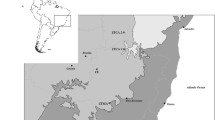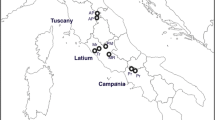Abstract
In this study, the first comprehensive multivariate statistical analysis of Danish native forest vegetation, based on 1768 sample plots, is presented. Data were composed of data from literature sources and newly collected data. A series of cluster analyses resulted in 24 forest community types, grouped in beech (Fagus sylvatica), oak (Quercus robur-Q. petraea), hornbeam (Carpinus betulus), alder-ash (Alnus-Fraxinus) and lime (Tilia cordata, T. platyphyllos) types, in addition to mixed forest communities with several co-dominant tree species. The described communities are provisionally arranged syntaxonomically, when possible, according to the international phytosociological system. The distribution of ecological indicator values of pH, soil moisture and nitrogen is gradual in relation to the perceived plant communities. Many forest types, such as beech and oak dominated types, obtain indicated values for pH that span most of the indicated gradient. It is suggested that natural Danish forests probably would be composed of a multitude of canopy forming tree species. The present stands with one or a few tree species forming the canopy is the result of long anthropogenic influence and selective logging.
Similar content being viewed by others
References
Aude, E. & Lawesson, J. E. 1998. Vegetation in Danish beech forests: the importance of soil, microclimate and management factors, evaluated by variation partitioning. Plant Ecology 134: 53–65.
Barkman, J. J., Moravec, J. & Rauschert, S. 1986. Code of phytosociological nomenclature. Vegetatio 67: 145–195.
Bjerke, S. 1957. Nogle træ k af de sydskandinaviske lø vskoves udvikling gennem de sidste å rhundreder. Dansk Dendrologisk Årsskrift 4: 373–413.
Böcher, T. W. 1946. Vegetationsstudier påHalvøen Ulvshale. Botanisk Tidsskrift 46: 1–42.
Bornebusch, C. H. 1920. Om bedø mmelsen af skovjordens godhed ved hjæ lp af bundfloraen. Dansk Skovfor. Tidskr. 5: 37–50.
Bornebusch, C. H. 1925. Skovbundsstudier. Det Forstlige Forsø gsvæ sen i Danmark 8: 1–148.
Bornebusch, C. H. 1931. Die Floratypen der dänischen Buchenwälder und ihre wirtschaftliche Bedeutung. Forstwissen Centralblatt. 53: 171–183.
Bornebusch, C. H. 1914. Studier over Rø dellens livskrav og dens optræ den i Danmark. Tidsskrift for Skovvæ sen 26: 28–99.
Braun-Blanquet, J. 1928. Pflanzensoziologie. Springer Verlag, Berlin.
Brunet, J. 1991. Die Vegetation der Erlenbruchwälder in Schonen (Südschweden). Tuexenia 11: 269–291.
Brunet, J. 1995. Sveriges bokskogar har gamla rötter. Svensk Botanisk Tidskrift 89: 1–10.
Brunet, J. Falkengren-Grerup, U. & Tyler, G. 1997. Pattern and dynamics of the ground vegetation in south Swedish Carpinus betulus forests: importance of soil chemistry and management. Ecography 20: 513–520.
Buchwald, E. 1993. Storbladet Lind og Sort Pil fundet som nye arter for Jylland. Flora og Fauna 99: 105–108.
Diekmann, M. & Lawesson, J. E. 1999. Shifts in ecological behaviour of herbaceous forest species along a transect from northern Central to North Europe. In: Marhold, K., Schmid, B. & Krahulec, F.: Ecology of closely related plant species. Special Features in Biosystematics and Biodiversity 3, pp. 133–148. Opulus Press, Uppsala.
Diekmann, M. 1994: Deciduous forest vegetation in Boreo-nemoral Scandinavia. Acta Phytogeographica Suecica 80: 1–112.
Diekmann, M. 1995a. Delimitation of syntaxa in northern Europe -a case study. Annali Botanica (Rome) LIII: 65–79.
Diekmann, M. 1995b: Use and improvement of Ellenberg's indicator values in deciduous forests of the Boreo-nemoral zone in Sweden. Ecography 18: 178–189.
Diekmann, M. Eilertsen, O., Fremstad, E., Lawesson, J. E. & Aude, E. 1999. Beech forests in the Nordic Countries -a multivariate analysis. Plant Ecology 140: 203–220.
Dierschke, H. 1994. Pflanzensoziologie. Eugen Ulmer, Stuttgart.
Dierssen, K. 1996. Vegetation Nordeuropas. Eugen Ulmer, Stuttgart.
Doing, H. 1963. Ñbersicht der floristischen Zusammensetzung, der Struktur und der dynamischen Beziehungen niederländischer Wald und Bebüschgesellschaften. Mededeelingen van de Landbouwhoogeschool te Wageningen 63(2): 1–60.
Döring-Mederake, U. 1990. Alnion forests in Lower Saxony (FRG), their ecological requirements, classification and position within Carici elongatae-Alnetum of Northern Central Europe. Vegetatio 89: 107–119.
Ellenberg, H., Weber, H. E., Düll, R., Wirth, V., Werner, W. & Paulißen, D. 1991: Zeigerwerte von Pflanzen in Mitteleuropa. Scripta Geobotanica 18: 1–248.
Fremstad, E. 1997. Vegetationstyper i Norge. NINA Temahefte 12. Tronheim.
Frödin, J. 1912. Tvenne västskandinaviska klimafaktorer och deras växtgeografiska betydelse. Arkiv för Botanik 11(12).
Gram, K., Jø rgensen, C. A. & Kø ie, M. 1944. De jyske Egekrat og deres Flora. Det Kongelige Danske Videnskabernes Selskab, Biologiske Skrifter 3(3): 1–210.
Grø ntved, P. 1936. Om floraen i nogle nordvestsjæ llandske Skove. Botanisk Tidsskrift 43: 325–356.
Halberg, K. 1993. Vorsø , vegetationsudvikling pånaturreservatet 1929- 92. Feltstationsrapport, Miljø ministeriet, Skov-og Naturstyrelsen.
Härdtle, W. 1995. Vegetation und Standort der Laubwaldgesellschaften (Querco-Fagetea) im nördlichen Schleswig-Holstein. Mittelungen der Arbeitsgemeinschaft Geobotanik in Schleswig-Holstein und Hamburg. 48: 1-441.
Helms, J. 1925. Gamle taks i Danmark. Den Kongelige Veterinæ rog Landbohø jskole Aarskrift: 186–248.
Iversen, J. 1958. Pollenanalytischer Nachweis des Reliktencharacters eines Jütischen Linden-Mischwaldes. Veröff. Geobot. Inst. Eidg. Tech. Hochsch. Stift. Rübel Zür. 33: 137–144.
Iversen, J. 1964. Retrogressive vegetational succession in the Post-Glacial. Journal of Ecology Supplement 52: 59–70.
Jensen, A. 1993. Dry coastal ecosystems of Denmark. In: van der Maarel, E. (ed). Dry coastal ecosystems. Polar regions and Europe. Ecosystems of the World 2A. Elsevier, Amsterdam. pp. 183–196.
Keller, W. 1974. Der Lindenmischwald des schaffhauser Randens. Berichte Schweizer Botanischer Geselschaft 84: 105–122.
Kielland-Lund, J. 1981. Die Waldgesellschaften SO-Norwegens. Phytocoenologia 9: 53–250.
Kielland-Lund, J. 1984. Syntaxonomy of norwegian forest vegetation 1993. Phytocoenologia 24: 299–310.
Kø ie, M. 1951. Relations of vegetations, soil and subsoil in Denmark. Dansk Botanisk Arkiv 14(5): 1–164.
Lange, J. 1866. Om forekomsten af Taxtræ et (Taxus baccata L.) i Danmark. Botanisk Tidsskrift 1: 51–54.
Lawesson, J. E. & Krienke, T. 1996. Phytosociology in Denmark -A review. Annali Botanica (Rome) 54: 23–30.
Lawesson, J. E. & Mark, S. 2000. The pH of Danish forest plants and a comparison with Ellenberg reaction values. Proceedings IAVS symposium 1998. In press.
Lawesson, J. E. (ed.), Eilertsen, O., Diekmann, M., Reinikainen, A., Gunnlaugsdottir, E., Fosaa, A. M., Carøe, I., Skov, F., Groom, G., Økland, T., Økland, R., Andersen, P. N., & Bakkestuen, V. 2000. A concept for vegetation studies and monitoring in the Nordic countries. TemaNord 2000: 517.
Lawesson, J. E. 1998. Quantitative terrestrial vegetation ecology in Denmark. Journal of Vegetation Science 9: 891–896.
Lawesson, J. E., Diekmann, M., Eilertsen, O., Fosaa, A. M. & Heikkilä, H. 1997. The Nordic Vegetation Survey -concepts and perspectives. Journal of Vegetation Science 8(3): 455–458.
Lawesson, J. E. 1999a. Review of Dierssen, K. 1996. Vegetation Nordeuropas. Eugen Ulmer, Stuttgart. Journal of Vegetation Science 10: 921–922.
Lawesson, J. E. 1999b. Quercus forests in the Nordic countries, a preliminary overview. Annali Botanica (Rome) LVII: 147–158.
Lindquist, B. 1931. Den skandinaviska bokskogens biologi. Svenska Skogvå rdsforeningens Tidskrift 3.
McCune, B. & Mefford, M. J. 1997. Multivatiate Analysis of Ecological data. PC-ORD for Windows, Vers. 3.04, MjM Software, Gleneden Beach, Oregon, USA.
Möller, H. 1970. Soziologisch-ökologische Untersuchungen in Erlenwäldern Holsteins. Mittelungen der Arbeitsgemeinschaft Geobotanik in Schleswig-Holstein und Hamburg 19: 1–110.
Mucina, L., Grabherr, G. & Wallnöfer, S. 1993. Die Pflanzengesellschaften Österreichs, 1- 3. Gustav Fischer Verlag, Jena.
Nielsen, O. F. 1982. Indvandring af Eg (Quercus robur) påHjelm Hede. Dansk Dendrologisk Årsskrift 5: 149–161.
Ødum, S. 1968. Udbredelsen af træ er og buske in Danmark. Botanisk Tidsskrift 64: 5–118.
Olsen, C. 1918. Undersø gelser over den store Næ ldes (Utrica dioeca) fordringer til voksestedet. Tidsk. Skovvæ sen 30(B): 1–45.
Olsen, C. 1938. Undersø gelser over bundfloraen i danske Egeskove og Egekrat. Botanisk Tidsskrift 44: 367–432.
Olsson, H. 1974. Studies on South Swedish sand vegetation. Acta Phytogeographica Suecica 60: 1–170.
Ostenfeld, C. H. 1918. Et par smaa naturlige egeskove påLolland. Dansk Skovforenings Tidsskrift 535–544.
Ostenfeld, C. H. 1920. Bemæ rkninger om danske træ er og buskes systematik og udbredelse. Dansk Skovforenings Tidsskrift 1920: 104–181.
Østergaard, J. 1957. Lindene i Jonstrupvang. Dansk Skovforenings Tidsskrift. 42: 281–285.
På hlsson, L. 1998. Vegetationstyper i Norden. TemaNord 1994: 665. Nordisk Ministerrå d, Kø benhavn.
Passarge, H. & Hofmann, G. 1968. Pflanzengesellschaften des norostdeutschen Flachlandes II. Gustav Fischer, Jena.
Passarge, H. 1966. Zur soziologischen Gliederung baltischer Buchenwaelder in Jüttland. Archiv für Forstwesen 15: 505–529.
Petersen, O. G. 1906. Forstbotaniske undersø gelser. Gyldendalske Boghandel, Nordisk Forlag, Kø benhavn.
Petersen, P. M. 1988. En botanisk beskrivelse af ni små skove påRø snæ s med præ g af tidligere tiders drift. Flora og Fauna 94(1): 15–22.
Pott, R. 1995. Die Pflanzengesellschaften Deutschlands, ed. 2. Ulmer, Stuttgart.
Raunkiæ r, C. 1921. Vegetationstypers indflydelse paa Jordbundens surhedgrad. Biologiske Meddelelser, Det Kongelige Danske Videnskabernes Selskab 3(10).
Rodwell, J. S. 1991. British Plant Communities, Vol. 1. Woodlands and scrub. Cambridge University Press, Cambridge.
Runge, F. 1983. Pflanzengesellschaften Bornholms. Tuexenia 3: 199–206.
Sissingh G. 1941. Ñber einige Waldgesellschaften der Insel Seeland (Dänemark). Beitrag zur Kenntnis der regionalen Verbre221 itung einiger Waldassoziationen. Mededeelingen van de Landbouwhoogeschool te Wageningen 45(2): 1–30.
Sissingh G. 1970. Dänische Buchenwälder. Vegetatio 21: 245–254.
Svenning, J.-C. & Magå rd, E. 1999. Population ecology and conservation status of the last natural population of English yew in Denmark. Biological Conservation 88: 173–182.
Tybirk, K. & Strandberg, B. 1999. Oak forest development as a result of historical land-use patterns and present nitrogen deposition. Forest Ecology and Management 114: 97–106.
Vaupell, C. 1863. De danske skove. P. G, ed. 2. (1986) Philipsens forlag/Forlaget Skippershoved.
Warming, E. 1895. Plantesamfund. Grundtræ k af den ø kologiske plantegeografi. P. G. Philipsen, Kø benhavn.
Warming, E. 1919. Skovene. Botanisk Tidsskrift 35: 1–653.
Westhoff, V. 1952. Gezelschappen met houtige gewassen in de duinen en langs de binnenduinrand. Jb. Nederl. Dendrol. Ver.: 9–49.
Wojterski, T. 1964. Pine forests on sand dunes at the Polish Baltic coast. Poznan Society of Friends of Science, Department of Mathematics and Natural Sciences, Section Biology 28(2): 217 pp.
Worsøe, E. 1985. Er Taks (Taxus baccata L.) vildvoksende i Danmark? Flora og Fauna 91: 22–26.
Worsøe, E. 1988. Naturlige skove i Danmark. Flora og Fauna 94: 53–64.
Rights and permissions
About this article
Cite this article
Lawesson, J.E. Danish deciduous forest types. Plant Ecology 151, 199–221 (2000). https://doi.org/10.1023/A:1026504103589
Issue Date:
DOI: https://doi.org/10.1023/A:1026504103589




